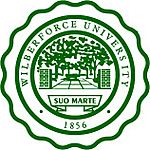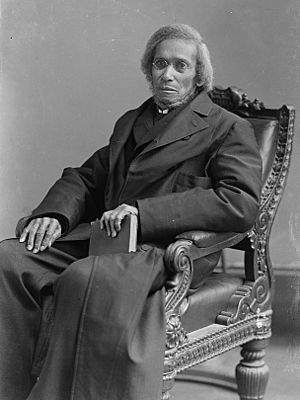Wilberforce University facts for kids

Seal of Wilberforce University
|
|
| Motto | Suo Marte |
|---|---|
|
Motto in English
|
By one's own toil, effort, courage |
| Type | Private historically black university |
| Established | 1856 |
|
Religious affiliation
|
African Methodist Episcopal Church |
|
Academic affiliations
|
Space-grant |
| President | Vann R. Newkirk, Sr. |
| Students | 701 |
| Location |
,
U.S.
39°42′27″N 83°52′50″W / 39.70750°N 83.88056°W |
| Campus | Rural |
| Colors | Green & Gold |
| Nickname | Bulldogs |
|
Sporting affiliations
|
NAIA – HBCUAC |
|
Carnegie Library (Old Wilberforce University Campus)
|
|
| Location | 1055 North Bickett Rd. Wilberforce, Ohio 45384 |
| Area | 0.5 acres (0.20 ha) |
| Built | 1907 |
| Architect | David Riebel |
| Architectural style | Classical Revival |
| NRHP reference No. | 04000610 |
| Added to NRHP | June 16, 2004 |
Wilberforce University (WU) is a private historically black university (HBCU) in Wilberforce, Ohio. It was one of the first HBCUs founded before the American Civil War. The school was started in 1856 by the Methodist Episcopal Church. It is named after William Wilberforce, a British leader who fought to end slavery.
In 1863, the university was sold to the African Methodist Episcopal Church (AME Church), which has been connected to the school since it began. Wilberforce University is still associated with the AME Church today.
For many years, the university was partly funded by the state of Ohio. In 1947, the state-funded part of the school became a separate university, which is now known as Central State University.
Wilberforce offers many different programs for students. Since 1966, the school has focused on cooperative education. This means students get hands-on experience through internships as part of their studies. The university's sports teams are called the Bulldogs.
Contents
History of Wilberforce University
A University is Born (19th Century)
Why a new school was needed
When Ohio became a state in 1802, it was a free state. This meant slavery was not allowed. Its southern neighbors, Kentucky and Virginia, were slave states. Because of this, Ohio became a key part of the Underground Railroad, a secret network that helped about 40,000 enslaved people escape to freedom.
As more Black people moved to Ohio, leaders realized there was a great need for education. In the 1850s, a movement grew to create colleges for Black students in the North. This was very different from the South, where it was illegal for Black people to be educated.
The founding of Wilberforce
Wilberforce University was founded in 1856. It was the third HBCU started in the United States. It was named after William Wilberforce, a British politician who worked to end slavery. The school was built at a place called Tawawa Springs, which had a large hotel and cottages that were turned into classrooms and student housing.
In its early years, many of the students were the mixed-race children of wealthy white Southern men. These fathers sent their children north to get an education that was not available to them in the South. By 1860, the university had over 200 students.
The Civil War and a new beginning
When the American Civil War started in 1861, the university faced serious money problems. The Southern families stopped sending their children and their money. The school had to close in 1862.
But the story didn't end there. In 1863, Bishop Daniel A. Payne of the AME Church bought the university for $10,000. He reopened the school and became its new president. This was a major turning point for Wilberforce.
Rebuilding after the war
Just as the Civil War was ending in 1865, a fire destroyed the main building on campus. It was a huge loss, but the school did not give up. Bishop Payne worked hard to raise money to rebuild. He received help from many people, including government leaders and private citizens.
During this time, the university improved its classes. It added programs in music, law, and science. In 1872, it started a program to train teachers, which allowed its graduates to work in public schools.
Growing with state help
In 1887, the Ohio government agreed to help fund a new department at Wilberforce. This was the "Combined Normal and Industrial Department" (CNI). It focused on training teachers and teaching job skills. This partnership brought much-needed money to the university.
The university also started a military training program in 1894. Lieutenant Charles Young, the third Black graduate of West Point, came to teach military science. By the 1890s, students were coming to Wilberforce from all over the world, including South Africa, Canada, and Mexico.
A Century of Change (20th Century)
Growth and new buildings
The early 1900s was a time of major growth for Wilberforce. The school added more programs and built several new buildings. These included a library funded by Andrew Carnegie, new dorms for students, and buildings for trade classes.
Under President William Sanders Scarborough, who served from 1908 to 1920, the number of students grew from 400 to over 1,500. The university also played an important role during World War I. Many students and professors served in the military, and the campus was used as an army training center.
The split with Central State
For many years, there was tension between the private part of Wilberforce (run by the AME Church) and the state-funded part (the CNI). The two parts had different boards and different goals.
In 1941, the CNI was renamed the College of Education and Industrial Arts (CEIA). The disagreements continued, and in 1947, the state of Ohio decided to separate the CEIA from Wilberforce completely. The CEIA became its own college, which was later renamed Central State University in 1965.
A new campus and modern times
After the split, Wilberforce University continued to grow. In 1967, it built a new campus about a mile away from the old one. Some of the historic buildings, like the Carnegie Library and Shorter Hall, are still used today.
In the 1970s, the university helped create the National Afro-American Museum and Cultural Center. This museum is now run by the Ohio Historical Society and shares the history and culture of African Americans.
Academics at Wilberforce
Wilberforce University offers many different subjects for students to study. A key part of the education at Wilberforce is the cooperative education program. This program helps students get internships in their field of study. This gives them real-world work experience while they are still in school.
Wilberforce Bulldogs Athletics
The university's sports teams are known as the Bulldogs. Wilberforce is a member of the National Association of Intercollegiate Athletics (NAIA). The teams compete in the HBCU Athletic Conference.
- Men's sports include basketball, golf, cross country, and track & field.
- Women's sports include basketball, volleyball, golf, cross country, and track & field.
Students can also play intramural sports like basketball, softball, and flag football for fun.
Notable Alumni
Many famous and successful people have graduated from Wilberforce University.
- Leontyne Price – A world-famous opera singer and the first African American to be a lead star at the Metropolitan Opera.
- Dorothy Vaughan – A brilliant mathematician who worked for NASA. Her story was featured in the movie Hidden Figures.
- W. E. B. Du Bois – A famous civil rights activist and writer who was a professor at Wilberforce.
- Bayard Rustin – A key organizer of the Civil Rights Movement.
- Floyd Flake – A former U.S. Congressman and a past president of Wilberforce.
- William Grant Still – A composer and conductor who was the first African American to have a symphony played by a major orchestra.
- Charity Adams Earley – The first African American woman to be an officer in the Women's Army Auxiliary Corps during World War II.
- Shontel Brown – A U.S. Congresswoman.
See also
- Historically black colleges and universities




